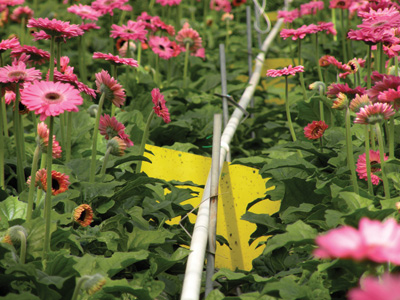
Integrated pest management is a key tool for both novice and seasoned
greenhouse vegetable growers, attendees at last year’s Saskatchewan
Green Trades Conference learned.
Integrated pest management is a key tool for both novice and seasoned greenhouse vegetable growers, attendees at last year’s Saskatchewan Green Trades Conference learned.

|
|
| React quickly to scouting reports and apply pesticides at appropriate times. Advertisement
|
Dr. Ken Fry’s talk was billed as an “introduction to IPM for beginners and a refresher for seasoned growers.” He’s co-ordinator of the Environmental Horticulture Program and an entomology instructor in the School of Environment at Olds College in Alberta.
Fry began his presentation with a definition of an IPM system as “a decision support system for the selection and use of pest management tactics singly or harmoniously co-ordinated into a management strategy, based on a cost-benefit analysis that takes into account the interests and impacts on producers, society and the environment.”
The elements of an IPM program, he noted, include monitoring, adopting strategies and tactics, and evaluation. Monitoring considerations include weather conditions, the phenology of the plants and pests, the location of the pests (in the soil, in surrounding plants or outside the plant area), the times when samples are taken, and what data are required.
THE IMPORTANCE OF CLOSE MONITORING
■ Monitoring can be done through direct observation, plant samples, or by various trapping methods. Common signs of pest damage, Fry pointed out, include stunted plants, mottled or yellow or curled leaves, necrotic spots, wilted plants, swollen plant parts and fewer, smaller or delayed flowers.
Fry provided an overview of different IPM options. He spoke first of cultural controls. This includes making use of crop production practices that also adversely affect the pest. This practice would also involve selecting varieties that are best suited for local growing conditions, removing diseased plants and all remnants of the old crop to prevent the spread of infection, and introducing footbaths and sterilizing equipment.
Physical measures may include capturing pests using pheromone-baited traps or preventing their entry by installing external screening.
Biological controls are natural processes and materials that can provide control, with minimal environmental impact, and often at low cost. The main focus here is on promoting beneficial insects that eat target pests.
TRANSPORT CONDITIONS CAN HAVE AN EFFECT
■ Transport conditions, however, can have a negative effect on the beneficial insects. He also noted that if the first release should fail or is of poor quality, the next release should be increased by up to five times to account for the increase in the pest population that has occurred while waiting for the replacement shipment to arrive.
To operate a successful biological control program, you also have to maintain a healthy physical environment – with proper airflow and the right temperature and humidity – as well as being careful about factors such as the use of fungicides, where hotspots of pest populations occur, and UV radiation. (“Hotspots” refers to small areas where local conditions are very amenable to the pest and you see the pest population is higher in that local spot than elsewhere in the greenhouse. You either have to release more biocontrol agents there or knock the population down with a localized application of pesticide before releasing the biocontrols.)
FOLLOW THE LABEL DIRECTIONS CAREFULLY
■ Synthetic pesticides should generally only be used as required and often only at specific times in a pest’s life cycle. Fry cautions that you should use only chemical products with a commercial label, follow the label directions carefully and spray only the target plants.
 |
|
| Dr. Ken Fry
|
He noted that timing is the biggest factor in the success of an IPM program. You have to react quickly to your scouting reports and apply pesticides at appropriate times.
The last stage, Fry said, is evaluation. Did your IPM work? Are insect levels going up or down? Which measures were most effective?
“You learn from your mistakes,” he said.
Fry is returning to the conference next month with a talk on “How to Integrate the New Controls and Enhance the Existing Tools for Biological Control of Insect Pests.”
Myron Love is a freelance writer/photographer in Manitoba.
Print this page